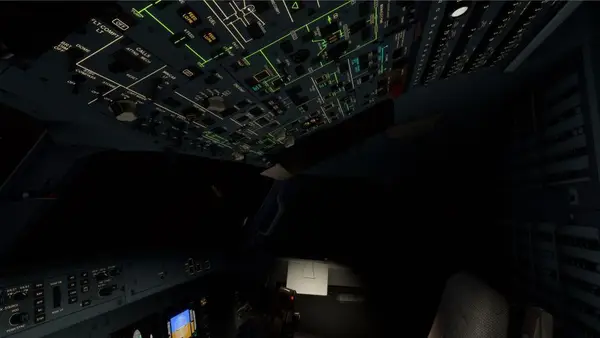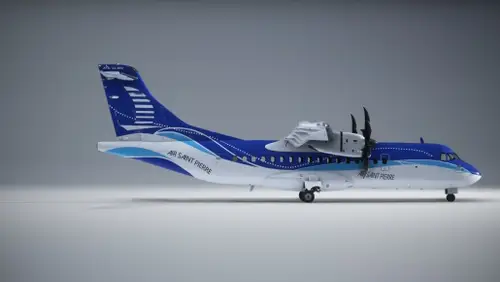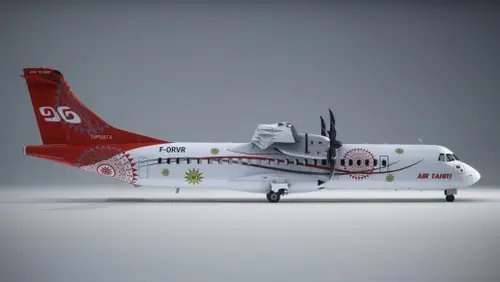The 42-600 is a twin-engine commuter airliner by the French-Italian aviation consortium ATR. The high-wing turboprop, which can seat up to 50 passengers, took its first flight in March of 2010 and was introduced into service in late 2012.
The 42-600 is an advanced iteration of the ATR 42, a family of regional airliners first conceived in the early 1980s. The ATR line has seen a wide range of uses, including commercial passenger, cargo, and military. ATR, which stands for “Regional Transport Aircraft” in both French and Italian, formed through the combined efforts of Aérospatiale (today Airbus) of France and Italy’s Aeritalia (today Leonardo) specifically to create the aircraft that they would designate the 42. Named “42” due to the number of seats of the original version, the aircraft was designed to be a highly-efficient airframe optimized for commuter lines, notably those serving the European market. The company has manufactured a total of nearly 500 airframes in the 42 lineage.
The prototype of the 42 line took its maiden flight on August 16, 1984 and the first production version, the 42-300, was introduced on December 3, 1985. This was followed by the -320, which was introduced in the late 1980s, then the -500, which began service in the mid-1990s. ATR launched the 42-600 in October of 2007 as an improved iteration of the 42-500 and currently remains in production.
The -600, which is operated by a flight crew of two, boasts an advanced glass cockpit, spacious cabin, and improved efficiency and performance over its predecessors. The aircraft measures 74 feet, 5 inches in length and stands 24 feet, 11 inches tall. It features a high-aspect ratio main wing with a span of 80 feet, 7 inches and a T-tail empennage. It is powered by two Pratt & Whitney Canada PW127XT-M engines, each delivering 2,400 horsepower to a 6-blade propeller.
The 42-600, while not designated a STOL (short take-off and landing) aircraft, has excellent short field and high-density altitude performance, with a take-off run of 3,631 feet at sea level, fully loaded. It has a range of 835 miles and a cruising speed of 345 miles per hour.
The ATR 42-600 is a masterpiece of modern aviation technology that is based on decades of its family’s successes. Distinctive in appearance with elegant lines and curves, it boasts thoroughbred performance in the air and has the ability to operate out of a wide variety of airfields throughout the world.
The 72-600 is a high-wing, twin-turboprop, regional airliner produced by the Franco-Italian company ATR. The aircraft took its maiden flight on July 24, 2009 and was introduced in 2010. The ATR 72-600 is crewed by two and can carry up to 78 passengers, although its standard configuration uses 70 seats. While used primarily as a passenger carrier, the 72-600 has seen use with a number of militaries for roles that include maritime patrol and logistical support.
The 72-600 is a refined version of the ATR 72, which is a stretched variant of the company’s ATR 42 family of aircraft. The company developed the 72 during the mid-1980s and the aircraft took its maiden flight on October 27, 1988. It was introduced into commercial service on October 27, 1989.
ATR developed a number of variants of the 72, with the 72-600 being one of its most notable. The airframe, announced in October of 2007, is based on the ATR 72-212A (also designated the 72-500). Among a number of improvements over previous iterations in the 72 line, the -600 boasts improved cabin design and an advanced multi-panel glass cockpit.
Although designed for and used as a short-haul carrier, the ATR 72-600’s form projects a tone of sportiness and performance. It features a long, sleek fuselage, a T-tail empennage, and has a high-aspect ratio main wing with a slight leading edge sweep. The wing has a span of 88 feet, 9 inches.
The 72-600 is powered by two Pratt & Whitney Canada PW127XT-M turboprop engines that each deliver 2,750 horsepower to 6-blade Hamilton Standard propellers. The ATR 72-600 has a range of 850 miles, a service ceiling of 25,000 feet above sea level, and a cruise speed of 320 miles per hour.
A stable performer that boasts a cockpit that optimizes pilot efficiency, the ATR 72-600 allows aviators to sharpen their skills and push their abilities to new heights as they cruise the airways, both busy and less-travelled, throughout the globe.
The ATR 42-600S is a twin-engine, turboprop-powered STOL (short take-off and landing) commercial regional airliner developed and manufactured by French-Italian aviation consortium ATR. The aircraft is an iteration of the 42-600 developed to take-off and land within just 800 meters (2,625 feet).
ATR, which stands for “Regional Transport Aircraft” in both French and Italian, formed through the combined efforts of Aérospatiale (today Airbus) of France and Italy’s Aeritalia (today Leonardo) to create their 42 series of twin-turboprop commercial airplanes. Named “42” due to the number of seats in the original version, the aircraft was conceived in the early 1980s to serve commuter lines in Europe. The 42 series prototype took its maiden flight on August 16, 1984, and the first production version, the 42-300, was introduced on December 3, 1985. The 42-600S, which took its maiden flight in May of 2022, was developed to service smaller communities throughout the world.
The ATR 42-600S features a high-mounted, high-aspect-ratio main wing, a T-tail empennage, and state-of-the-art avionics and flight controls. It is piloted by two and can carry up to 50 passengers. The aircraft measures 74 feet, 5 inches in length, stands 24 feet, 11 inches tall, and has a wingspan of 80 feet, 7 inches. It is powered by two Pratt & Whitney Canada PW127XT-L turboprop engines that each develop up to 2,750 shaft horsepower. Each powerplant turns a 6-blade, constant-speed propeller. The aircraft can take-off and land within 2,625 feet, has a range of 780 miles, a service ceiling of 25,000 feet above sea level, and a cruising speed of 333 miles per hour.
The ATR 72-600F is a twin-engine, turboprop-powered regional freighter developed and manufactured by French-Italian aviation consortium ATR. The purpose-built cargo aircraft is a variant of the ATR 72-600, a commercial airframe that traces its lineage to ATR’s 42 family, the prototype of which took its maiden flight on August 16, 1984. The ATR launched the 72-600F program in late 2017 and the aircraft took its first flight on September 16, 2020. The model, which fulfills an important niche in aerial logistics, is the world’s only purpose-built regional cargo aircraft.
ATR, which stands for “Regional Transport Aircraft” in both French and Italian, formed through the combined efforts of Aérospatiale (today Airbus) of France and Italy’s Aeritalia (today Leonardo) to create their 42 series of twin-turboprop commercial airplanes. Named “42” due to the number of seats in the original version, the aircraft was conceived in the early 1980s to serve commuter lines in Europe.
The 42 series prototype took its maiden flight on August 16, 1984, and the first production version, the 42-300, was introduced on December 3, 1985. ATR developed the 72, a stretched iteration of the 42, in the mid-1980s, and the aircraft took its first flight on October 27, 1988. The 72-600 is one of the most notable variants of the 72 line due to its performance and reliability leading ATR to choose it for a novel cargo aircraft. Primary modifications over the passenger-carrying 72-600 include a lack of cabin windows, a large cargo door on the forward left fuselage, and strengthened floors. More than 160 of the aircraft are in service and it has proven commercially successful on routes throughout the globe.
The 72-600F features a high-mounted, high-aspect-ratio main wing, a T-tail empennage, and a flight deck comprising state-of-the-art avionics and flight controls. It measures 89 feet, 2 inches in length, stands 25 feet, 1 inch tall, and has a wingspan of 88 feet, 9 inches. It is powered by two Pratt & Whitney Canada PW127XT-M turboprop engines that each generate up to 1,750 shaft horsepower. Each engine turns a 6-blade, constant speed propeller.
The 72-600F has a cargo capacity of 2,649 cubic feet, a maximum structural payload of 20,281 pounds, and it can accommodate standard pallets and LD-3 containers. It has a range of 1,185 miles, a service ceiling of 25,000 feet above sea level, and a high-speed cruising speed of 316 miles per hour.



































